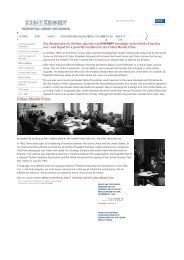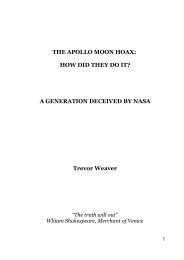14.13 - Mars Rovers
Create successful ePaper yourself
Turn your PDF publications into a flip-book with our unique Google optimized e-Paper software.
The image, taken by Curiosity, appears to show the vertebrae of a large animal or sea creature, such as<br />
a walrus or arctic whale. For comparison, below is an image of a whale skeleton.<br />
Figure 17 – Whale Skeleton<br />
Looking at the central section of the whales vertebrae in the diagram above, we see a similarity with<br />
the mars rover image. Walruses are known to drag themselves on land and huddle up in a group to<br />
sunbathe. The early walrus ivory hunters would shoot whole groups of Walruses in one spot, take the<br />
tusks and heads and leave the bodies to rot, so there would be backbones without skulls left. These<br />
places are known as Walrus graveyards, and have been discovered on Svalbard, where <strong>Mars</strong> rover<br />
research has been carried out.<br />
The image could be a peculiar geological feature consisting of notches, cups and holes created by<br />
erosion and disposition. Perhaps the way the light is falling on the geology creates an image which<br />
looks like a vertebra, but is in fact geology. The image below shows more of the surrounding area.<br />
Does this image show peculiar looking geological features or an animal “vertebrae”?<br />
Figure 18 – A wider view showing some of the surrounding geology<br />
Another question which arises is if this anomaly is part of an animal’s vertebra. What could the<br />
formation in the red square of Figure 19 represent? Is this also part of an animal skeleton, if so what<br />
part?<br />
15





